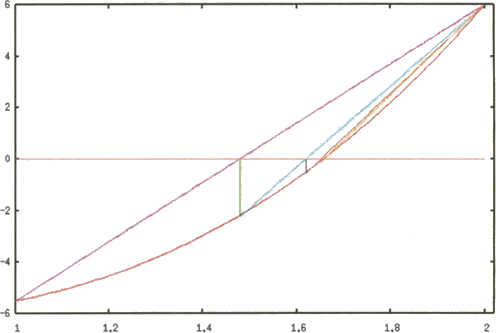
Next: Modified Regular Falsi method:
Up: MAIN
Previous: Bracketing Methods:
Bisection method converges slowly. Here while defining the new
interval
![]() the only utilization of the function
the only utilization of the function
![]() is in checking whether
is in checking whether
![]() but not in
actually calculating the end point of the interval. False Position
or Regular Falsi method uses
but not in
actually calculating the end point of the interval. False Position
or Regular Falsi method uses ![]() not only in deciding the new
interval
not only in deciding the new
interval
![]() as in bisection method but also in
calculating one of the end points of the new interval. Here one of
end points of
as in bisection method but also in
calculating one of the end points of the new interval. Here one of
end points of
![]() say
say ![]() is calculated as a weighted
average defined on previous interval
is calculated as a weighted
average defined on previous interval
![]() as
as
![]()


(
![]() have opposite signs).
have opposite signs).
The algorithm for computing the root of function ![]() by this
method is given below.
by this
method is given below.
Algorithm:
Given a function ![]() continuous on an interval
continuous on an interval ![]() satisfying the
criteria
satisfying the
criteria
![]() , carry out the
following steps to find the root
, carry out the
following steps to find the root ![]() of
of ![]() in
in ![]() :
:
(1) Set
![]()
(2) For n = 0,1,2.... until convergence criteria is satisfied ,
do:
(a) Compute 
(b) If
![]() , then
set
, then
set
![]()
otherwise
set
![]()
Note:
Use any one of the convergence criteria discussed earlier under
bisection method. For the sake of carrying out a comparative study we
will stick both to the same convergence criteria as before i.e.
![]() (say)
and to the example problems.
(say)
and to the example problems.
Example:
Solve
![]() for the root in the
interval [1,2] by Regula-Falsi method:
for the root in the
interval [1,2] by Regula-Falsi method:
Solution: Since
![]() , we go ahead in
finding the root of given function f(x) in [1,2].
, we go ahead in
finding the root of given function f(x) in [1,2].
Set
![]() .
.


set
![]()
![]() , proceed with
iteration.
, proceed with
iteration.
Iteration details are provide below in a tabular form:
| Regula Falsi Method | ||||
|---|---|---|---|---|
| Iteration no. | ||||
| 0 | 1.0000000000 | 2.0000000000 | 1.4782608747 | -2.2348976135 |
| 1 | 1.4782608747 | 2.0000000000 | 1.6198574305 | -0.5488323569 |
| 2 | 1.6198574305 | 2.0000000000 | 1.6517157555 | -0.1169833690 |
| 3 | 1.6517157555 | 2.0000000000 | 1.6583764553 | -0.0241659321 |
| 4 | 1.6583764553 | 2.0000000000 | 1.6597468853 | -0.0049594725 |
| 5 | 1.6597468853 | 2.0000000000 | 1.6600278616 | -0.0010169938 |
| 6 | 1.6600278616 | 2.0000000000 | 1.6600854397 | -0.0002089010 |
| 7 | 1.6600854397 | 2.0000000000 | 1.6600972414 | -0.0000432589 |
| 8 | 1.6600972414 | 2.0000000000 | 1.6600997448 | -0.0000081223 |

is the point of intersection of the secant to ![]() , passing
through points
, passing
through points
![]() and
and
![]() with the
x-axis. Since here
with the
x-axis. Since here ![]() is concave upward and increasing the
secant is always above
is concave upward and increasing the
secant is always above ![]() . Hence,
. Hence, ![]() always lies to the left
of the zero. If
always lies to the left
of the zero. If ![]() were to be concave downward and increasing,
were to be concave downward and increasing,
![]() would always lie to the right of the zero.
would always lie to the right of the zero.

Example:
Solve
![]() for the root
in the interval [0.5,1.5] by Regula Falsi method.
for the root
in the interval [0.5,1.5] by Regula Falsi method.
| Regula Falsi Method | ||||
|---|---|---|---|---|
| Iteration no. | ||||
0 |
0.5000000000 | 1.5000000000 | 0.8773435354 | 2.1035263538 |
1 |
0.5000000000 | 0.8773435354 | 0.7222673893 | 0.2828366458 |
2 |
0.5000000000 | 0.7222673893 | 0.7032044530 | 0.0251714624 |
3 |
0.5000000000 | 0.7032044530 | 0.7015219927 | 0.0021148270 |
4 |
0.5000000000 | 0.7015219927 | 0.7013807297 | 0.0001767781 |
5 |
0.5000000000 | 0.7013807297 | 0.7013689280 | 0.0000148928 |
6 |
0.5000000000 | 0.7013689280 | 0.7013679147 | 0.0000009526 |
Exercise: 1) Solve ![]() for the root in the interval [2,3] by Regula-Falsi Method.
for the root in the interval [2,3] by Regula-Falsi Method.
2) Find the solution to
, in the interval [1,2] accurate to within
using Regula-Falsi Method.